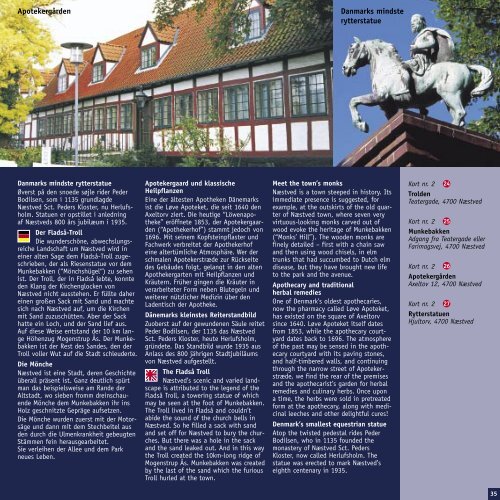Velkommen til DIN ferie! - INKA Consult
Velkommen til DIN ferie! - INKA Consult
Velkommen til DIN ferie! - INKA Consult
You also want an ePaper? Increase the reach of your titles
YUMPU automatically turns print PDFs into web optimized ePapers that Google loves.
Apotekergården Danmarks mindste<br />
rytterstatue<br />
Danmarks mindste rytterstatue<br />
Øverst på den snoede søjle rider Peder<br />
Bodilsen, som i 1135 grundlagde<br />
Næstved Sct. Peders Kloster, nu Herlufsholm.<br />
Statuen er ops<strong>til</strong>let i anledning<br />
af Næstveds 800 års jubilæum i 1935.<br />
Der Fladså-Troll<br />
Die wunderschöne, abwechslungsreiche<br />
Landschaft um Næstved wird in<br />
einer alten Sage dem Fladså-Troll zugeschrieben,<br />
der als Riesenstatue vor dem<br />
Munkebakken (“Mönchshügel“) zu sehen<br />
ist. Der Troll, der in Fladså lebte, konnte<br />
den Klang der Kirchenglocken von<br />
Næstved nicht ausstehen. Er füllte daher<br />
einen großen Sack mit Sand und machte<br />
sich nach Næstved auf, um die Kirchen<br />
mit Sand zuzuschütten. Aber der Sack<br />
hatte ein Loch, und der Sand lief aus.<br />
Auf diese Weise entstand der 10 km lange<br />
Höhenzug Mogenstrup Ås. Der Munkebakken<br />
ist der Rest des Sandes, den der<br />
Troll voller Wut auf die Stadt schleuderte.<br />
Die Mönche<br />
Næstved ist eine Stadt, deren Geschichte<br />
überall präsent ist. Ganz deutlich spürt<br />
man das beispielsweise am Rande der<br />
Altstadt, wo sieben fromm dreinschauende<br />
Mönche dem Munkebakken ihr ins<br />
Holz geschnitzte Gepräge aufsetzen.<br />
Die Mönche wurden zuerst mit der Motorsäge<br />
und dann mit dem Stechbeitel aus<br />
den durch die Ulmenkrankheit gebeugten<br />
Stämmen fein herausgearbeitet.<br />
Sie verleihen der Allee und dem Park<br />
neues Leben.<br />
Apotekergaard und klassische<br />
Heilpflanzen<br />
Eine der ältesten Apotheken Dänemarks<br />
ist die Løve Apoteket, die seit 1640 den<br />
Axeltorv ziert. Die heutige “Löwenapotheke”<br />
eröffnete 1853, der Apotekergaarden<br />
(“Apothekerhof”) stammt jedoch von<br />
1696. Mit seinem Kopfsteinpflaster und<br />
Fachwerk verbreitet der Apothekerhof<br />
eine altertümliche Atmosphäre. Wer der<br />
schmalen Apotekerstræde zur Rückseite<br />
des Gebäudes folgt, gelangt in den alten<br />
Apothekergarten mit Heilpflanzen und<br />
Kräutern. Früher gingen die Kräuter in<br />
verarbeiteter Form neben Blutegeln und<br />
weiterer nützlicher Medizin über den<br />
Ladentisch der Apotheke.<br />
Dänemarks kleinstes Reiterstandbild<br />
Zuoberst auf der gewundenen Säule reitet<br />
Peder Bodilsen, der 1135 das Næstved<br />
Sct. Peders Kloster, heute Herlufsholm,<br />
gründete. Das Standbild wurde 1935 aus<br />
Anlass des 800 jährigen Stadtjubiläums<br />
von Næstved aufgestellt.<br />
The Fladså Troll<br />
Næstved’s scenic and varied landscape<br />
is attributed to the legend of the<br />
Fladså Troll, a towering statue of which<br />
may be seen at the foot of Munkebakken.<br />
The Troll lived in Fladså and couldn’t<br />
abide the sound of the church bells in<br />
Næstved. So he filled a sack with sand<br />
and set off for Næstved to bury the churches.<br />
But there was a hole in the sack<br />
and the sand leaked out. And in this way<br />
the Troll created the 10km-long ridge of<br />
Mogenstrup Ås. Munkebakken was created<br />
by the last of the sand which the furious<br />
Troll hurled at the town.<br />
Meet the town’s monks<br />
Næstved is a town steeped in history. Its<br />
immediate presence is suggested, for<br />
example, at the outskirts of the old quarter<br />
of Næstved town, where seven very<br />
virtuous-looking monks carved out of<br />
wood evoke the heritage of Munkebakken<br />
(“Monks’ Hill”). The wooden monks are<br />
finely detailed – first with a chain saw<br />
and then using wood chisels, in elm<br />
trunks that had succumbed to Dutch elm<br />
disease, but they have brought new life<br />
to the park and the avenue.<br />
Apothecary and traditional<br />
herbal remedies<br />
One of Denmark’s oldest apothecaries,<br />
now the pharmacy called Løve Apoteket,<br />
has existed on the square of Axeltorv<br />
since 1640. Løve Apoteket itself dates<br />
from 1853, while the apothecary courtyard<br />
dates back to 1696. The atmosphere<br />
of the past may be sensed in the apothecary<br />
courtyard with its paving stones,<br />
and half-timbered walls, and continuing<br />
through the narrow street of Apotekerstræde,<br />
we find the rear of the premises<br />
and the apothecarist’s garden for herbal<br />
remedies and culinary herbs. Once upon<br />
a time, the herbs were sold in pretreated<br />
form at the apothecary, along with medicinal<br />
leeches and other delightful cures!<br />
Denmark’s smallest equestrian statue<br />
Atop the twisted pedestal rides Peder<br />
Bodilsen, who in 1135 founded the<br />
monastery of Næstved Sct. Peders<br />
Kloster, now called Herlufsholm. The<br />
statue was erected to mark Næstved’s<br />
eighth centenary in 1935.<br />
Kort nr. 2 24<br />
Trolden<br />
Teatergade, 4700 Næstved<br />
Kort nr. 2 25<br />
Munkebakken<br />
Adgang fra Teatergade eller<br />
Farimagsvej, 4700 Næstved<br />
Kort nr. 2 26<br />
Apotekergården<br />
Axeltov 12, 4700 Næstved<br />
Kort nr. 2 27<br />
Rytterstatuen<br />
Hjultorv, 4700 Næstved<br />
35



